T-SHIRT PRINTING NEWBIE?
What you need to know before screen printing your first t-shirt. Download our FREE artwork cheatsheet to find out your mesh count and read on for a quick overview.
WHICH MESH COUNT FOR SCREEN PRINTING T-SHIRTS?
I could easily chuck a mesh count number your way but in reality this is based on your artwork and the type of ink you are using. Here are some artwork examples :

This is a single colour vector image. There are no small details, vector images create crisp and clear lines – this would be one of the easiest design type to get started in screen printing t-shirts.
If you are using waterbased ink – We would suggest using a 43t mesh (110t US measure).

Photographic images are actually pretty easy to achieve. This is still a single colour image. You need to transform the image into halftone dots before printing.
If you are purchasing your acetate or pre-exposed screen from Squeegee & Ink, we can create halftones for you! Alternatively, you can download our FREE mesh/halftone chart and have a go yourself.
For this style image, we would suggest using a 62t mesh (156t US measure)
https://www.squeegeeandink.co.uk/product/mesh-halftone-chart/

This is a spot colour design – Solid colours in the same image to create a multi colour image. So long as your design does not have fine detail, we would recommend using a 43t mesh. If you do have fine detail, consider using a 55t or 62t instead.

CMYK printing is in a league of its own. As you are using fine halftone dots we would suggest using a 62t (156t US measure) when printing with Plastisol ink onto t-shirts.

Simulated process is one of the most advanced screen printing methods. Your mesh count may change for each colour. Generally, we would suggest using a 43t for the white underbase and then 62t-90t for the other colours.
QUICK GUIDE TO CHOOSING THE RIGHT MESH COUNT
We have a downloadable mini-course walking through everything you need to know about our FREE artwork cheatsheet. We explain the difference between vector and raster images. Printing your film positives, exposure and even printing your design.





